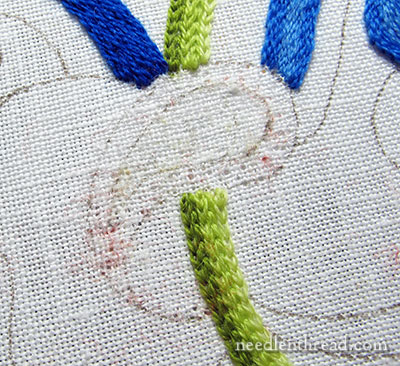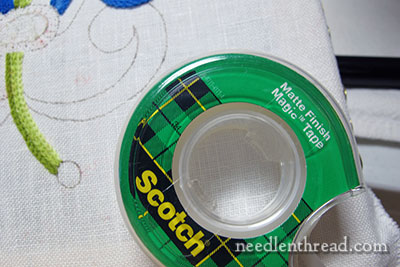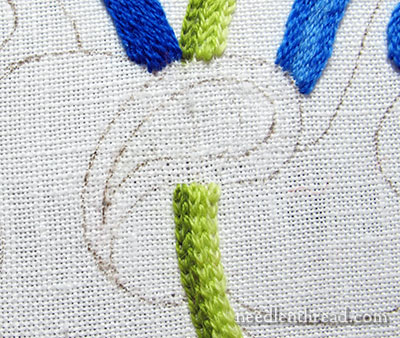I know it’s hard to believe that embroidery and Scotch tape have much to do with each other.
But I’ll tell you what! If you don’t have a at least a small reel of Scotch tape somewhere in your stitching supplies, you should!
It doesn’t have to be Scotch tape in particular – as long as it’s an easy-release tape. I think it helps, too, if it’s at least somewhat transparent.
Allow me to demonstrate…

Last week, we discussed my kerfuffle with this wool embroidery sample I’m working on. So many of you offered excellent input, suggestions, encouragement – I had fun reading all the comments, and I’m still going back through them and re-reading, because the dilemma is not completely resolved.
One fact became clear pretty quickly when I approached the project again: a repair job on the current stitching wasn’t going to do it! The stitches had to come out.
(This happens to me a lot, doesn’t it? But you know what? That’s part of the process, and if you consider it that way, you won’t feel overwhelmed, depressed, frustrated, or even infuriated when you find you have to do some reverse stitching!)

When picking out embroidery stitches, and especially stitches worked in wool, this stuff – this “magic tape” – really is magic. And it’s darned convenient to have around.
If you look at the first photo in this article, you can see that the removal of the wool threads left a lot of residue on the fabric. I could meticulously pick it all off with tweezers. I could even use a small scrap of cloth (flannel works great) and rub over the areas for a while, and eventually pick up most of it.
But tape… ahhhh, tape! Tape works wonders in situations like this. And it works those wonders very quickly!
Just apply a little bit of tape, sticky side down, to the fabric, dabbing it on wherever thread residue resides.

I snapped this photo immediately after applying tape to the front of the area once.
When removing thread residue, flip the work and dab off any lingering fibers on the back, too. You don’t want to carry fibers stuck on the back through to the front with your next round of stitching.
Now I have a clean enough slate to try, try again, thanks to this often overlooked, but highly efficient, sticky tool – tape.
Next time you’re out, pick up a roll of tape to keep handy on your work table or in your project basket. You’ll be glad you did!







I was SO excited when you replied to me yesterday!
And, thanks for the tip. I’ll go put a roll in my bag right now.
And, oh yeah, I’d love to send you a picture of my Holly & Joy, but how would you like for me to send it to you?
Faithful Reader,
Sarah
Hi, Sarah – you can email me at mary (at) needlenthread (dot) com – and just attach the photo to the email. I’m excited to see it!
Yep. Tape! It’s wonderful stuff!
Dear Mary
When I unpick stitches I use sellotape ever since you wrote about it a while ago it certainly does get rid of the residue left after unpicking thread. Thanks for the tip and I’m glad you have sorted out your kerfuffle happy weekend stitching hopefully your electricity is also sorted.
Regards Anita Simmance
Mary, I use double face tape, make it into a tiny loose ball (size of a small “spitball”) & drop it onto the mess, roll it around with a laying tool, then of course, rub the fabric, scrub-style, to eliminate the needle holes.
Totally agree…always keep a small roll of tape with my work….
G’day Mary,
Simple but delightfully effective. I don’t know if it would apply here but with using masking tape to position art work we were taught to lightly ‘stick’ it to our clothing first to release the first burst of sticky, therefore making the tape more acid free.
Sticky tape is also handy for removing the surface layer of paper, and therefore hopefully the offending writing, on a page, especially for removing a previous name inside a book, or a price etc.
Thanks Mary, cheers, Kath
I’ll have to ask my mom to help me with that when it’s done. It’s not done yet!
By that I mean, I’ll have to ask my mom to help me send a picture of my Holly and Joy project to you via e-mail when it’s done.
Wow, this came just in time. I was embroidering on white wool felt with teal blue thread and decided I didn’t like the look, so I picked it out the best I could. Naturally it left some residue behind. I’m going to try this trick asap! Thanks and Happy Holidays.
What a great tip!
Thanks awfully much.
When my now adult children were growing up, they were usually impatient with projects. I/we would always tell them that if you sew, you will use a seam ripper. If you knit, you will rip out stitches..or more! If you draw with graphite, you will erase. If you paint with watercolor, you may need to start over. If you work in steel, you will weld or throw it out. Measure twice and cut once.
And if you embroider, you will very very carefully, snip or remove those areas that need to be reworked. Leaving the ground fabric in perfect condition!
It is never fun correcting mistakes, but when it all comes together, it is a joy! (And maybe a big relief as well. 🙂
Hi Mary, Here in the Uk we have a roller of sticky paper that you can buy from dry cleaning shops and some hardware stores (that’s what we call them – sell all kinds of household goods)which takes fluff from garments when it’s stuck to them and would do this job very well indeed. I bet they’ve got it in USA somewhere too.
I find that Scotch blue painter’s tape works especially well to remove fuzz. It’s thicker than cellophane tape so it’s easier to handle. But I also keep cellophane, double sided tape and the pink hair dresser’s tape in my sewing room. All are very handy. Also, if I have holes in the fabric after removing stitches, I mist it with water and let it sit overnight, this helps to relax the fibers. Obviously, not for all situations, but helpful when appropriate.
Ah, thanks for that tip. I have some satin stitch I must redo on my Schwalm embroidery and this could be just what I need.
Oh my, I don’t know where I would be or how I would survive without my Scotch tape! It is an absolute must! Not only fabulous for cleaning off fibers, also great to dab off excess lead from pencil lines to stop them smudging.
I accidentally came across another use for sellotape and embroidery….double-sided tape especially. Take a small piece, about an inch, wrap it around tip of middle finger….and shove that ill-fitting, irritating thimble on top o it! Holds thimble in place until you want it back in its’ box!!
Love your work, especially the Mission Rose!
Yes, I use that too, from time to time. It’s a trick I picked up years and years ago when I was in the Sea Cadets and we used to use tape as a very effective clothes brush! You just wind it around your fingers with the sticky side out and brush away.=)
I was taught that Mistooks, provide insightful learning, given that the learning takes place. The process is the most important part of doing anything that is worth doing. Thank you for the tip on the scotch tape.
Great idea!